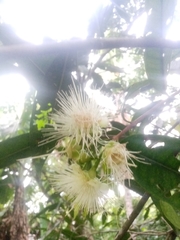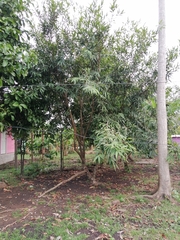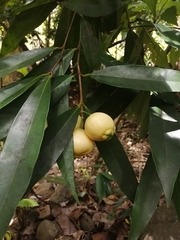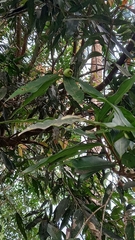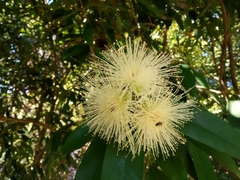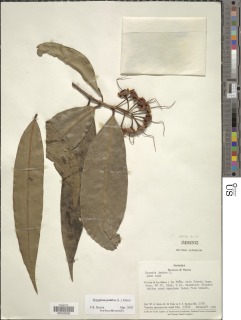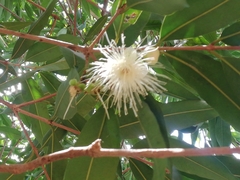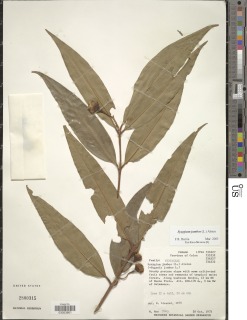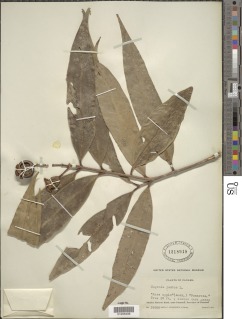

|
|
|
|
Family: Myrtaceae
Malabar-Plum, more... (es: Pomarosa)
[Eugenia jambos L.] |
Descripción: Árbol de 5 a 20 m de alto. Copa redondeada y con follaje lustroso. Tronco ramificado a baja altura. Ramitas terminales ligeramente aplanadas y de color marrón. Hojas simples y opuestas, de 10-22 x 3-6 cm, lanceoladas o elípticas, con ápice largamente acuminado, bordes enteros y base decurrente o redondeada. Las hojas son coriáceas y glabras, con nervaduras secundarias finas y paralelas. Pecíolo de 0.5-1 cm de largo y acanalado en la parte superior. Flores blancas y con numerosos estambres. Frutos globosos, de 3-5 cm de largo, verdes y con una estructura en forma de corona en la punta, tornándose rosados o amarillos al madurar. Datos Ecológicos: La especie ocurre a bajas y medianas elevaciones, en lugares húmedos o muy húmedos. Es nativo de la región Indo-Malaya, pero se encuentra cultivado y naturalizado en muchos lugares de Panamá. Florece y fructifica de enero a julio. Las flores son visitadas por abejas y otros insectos. Las semillas son dispersadas por animales. Especies Parecidas: A menudo se confunde con LK syzyma Syzygium malaccense LK2 conocido popularmente como marañón curasao, pero en Syzygium malaccense las hojas son de mayor tamaño y las flores son rosadas o rojas. Usos: Los frutos maduros son comestibles. Glabrous trees, to 15 m tall, ca 30 cm dbh. Petioles 5-10 mm long; blades oblong-lanceolate, acuminate, acute to obtuse at base, 12-22 cm long, 3-5 cm wide, pellucid-punctate. Flowers 1-5 at ends of branchlets, 4-parted, glabrous; pedicels ca 1.5 cm long; receptacle 1-1.5 cm long; sepals semicircular, recurved at anthesis, 5-7 mm long, persistent in fruit; petals white, l-2 cm long, ovate, pellucid-punctate; stamens many; stamens and style long-exserted. Berries subglobose to pear-shaped, 2-3 cm diam, green to pinkish or yellowish at maturity; seeds 2 to several. Croat 7413. Infrequent, along some areas of the shore. The species is apparently naturalized but may be the result of former habitation. Flowers mainly in the dry season (rarely November to as late as May). Fruit maturity time has not been determined. Native to the East Indies; cultivated and escaped throughout tropical America. In Panama, reported from low and middle elevations in moist and wet areas, often in pastures (Holdridge, 1970); known from tropical moist forest in the Canal Zone, Bocas del Toro, Colón and Panama. See Fig. 426. Bocas Species Database Habitat: The Rose apple grows optimally in full sun and at elevations ranging from sea level to 3,000 feet. Distribution: This tree is native to India and Malaysia. It was introduced in the Americas in 1762 and is now present from southern Mexico to Peru. The tree can be quite invasive where it is introduced. It has became a treat is different islands such as Hawaii and Australia. Natural History Notes: The Rose apple is not a very exploited fruit and is rather consumed locally in the tropics. It can be consumed freshly picked from the tree or used to make jams and jellies. Since the flavor is not very strong, the Rose apple is often mixed with other fruits. In Jamaica, the juice of the fruit is extracted and boiled to make heavy sugared syrup that is then used in sauces or in cold drinks. The fruit can also be sliced in two and stewed with sugar and then served as dessert. However, it is important to never eat the seeds or cook them because they are toxic! The rich, rose-like scent essential oil made out of the fruit and the leaves is used as a base for perfumes. The Rose apple is also used an as ornamental tree and as a hedgerows around coffee plantations. Finally, the fruit is an important food source for honeybees. Characteristics: Rose apple is an evergreen tree of 7-12 m that can be recognized by its dense crown of thin, spread branches. The leaves have an opposite arrangement and have a fine elliptic pointed shape with a dark-green coloration or a rosy coloration when the leaves are young. The flowers are creamy-white and have a funny pompon shape. They usually emerge as small clusters at the terminal end of a branch. The fruit has a rounded-oval shape of 4-5 cm long with a smooth, pale-yellow skin. The inside of the fruit is composed of a yellow, juicy flesh and a cavity in the center that contains 1-4 brown, rounded seeds. The scent of the fruit is sweet and reminds the scent of a rose, which explains its common name Rose apple. The tree flowers and fruits throughout the year. The dispersion is achieved by seeds, which have a rather short viability. |


